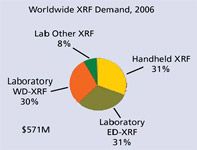Market Profile: Handheld XRF
Although X-ray fluorescence spectroscopy (XRF) has long been a tool of the laboratory, the past few years have seen a meteoric rise in the use of handheld XRF units for applications in which a portable unit can increase the speed and efficiency of the testing process. Some years ago, handheld instruments required the use of radioactive materials to provide a source of X-rays, but the development of low-power X-ray tubes has enabled this market to flourish by removing any apprehension about using regulated materials.
Although X-ray fluorescence spectroscopy (XRF) has long been a tool of the laboratory, the past few years have seen a meteoric rise in the use of handheld XRF units for applications in which a portable unit can increase the speed and efficiency of the testing process. Some years ago, handheld instruments required the use of radioactive materials to provide a source of X-rays, but the development of low-power X-ray tubes has enabled this market to flourish by removing any apprehension about using regulated materials.

Worldwide XRF Demand, 2006
Originally, the main application focus of handheld XRF was in positive material identification (PMI) tests of metals, such as scrap metals for recycling. Identifying and separating different grades of steel, for instance, could be done easily in the field. More recently, handheld XRF has been identified as an important part of the solution for compliance with environmental regulations like the EU's Restriction of Hazardous Substances (RoHS) directive, which took effect in July of 2006. Although laboratory testing will provide more conclusive results, manufacturers of plastics, metals, and electronic components are rapidly adopting handheld XRF as the first-line screening method of choice.
The total market for handheld XRF grew about 70% in 2006, reaching $126 million. Growth for 2007 should remain well into the double digits, although this pace will soon become more moderate.
The foregoing data were extracted from SDi's market analysis and perspectives report entitled Global Assessment Report, 9th Edition: The Laboratory Life Science and Analytical Instrument Industry, September 2006. For more information, contact Michael Tice, VP of Consulting Services, Strategic Directions International, Inc., 6242 Westchester Parkway Suite 100, Los Angeles, CA 90045, (310) 641-4982, fax: (310) 641-8851, www.strategic-directions.com.

Portable and Wearable Spectrometers in Our Future
December 3rd 2024The following is a summary of selected articles published recently in Spectroscopy on the subject of handheld, portable, and wearable spectrometers representing a variety of analytical techniques and applications. Here we take a closer look at the ever shrinking world of spectroscopy devices and how they are used. As spectrometers progress from bulky lab instruments to compact, portable, and even wearable devices, the future of spectroscopy is transforming dramatically. These advancements enable real-time, on-site analysis across diverse industries, from healthcare to environmental monitoring. This summary article explores cutting-edge developments in miniaturized spectrometers and their expanding range of practical applications.
Q&A: Portable FT-IR Empowers On-Site Food Quality Assurance
February 1st 2024Exploring the transformative capabilities of handheld Fourier transform infrared (FT-IR) spectrometers, Luis Rodriguez-Saona of The Ohio State University emphasizes their pivotal role in ensuring food integrity and safety across the entire supply chain.
Portable Raman Spectrometers: How Small Can They Get?
June 1st 2023There is a growing desire among spectroscopists for having instruments small enough to be taken to the sample, as opposed to bringing the sample to the instrument. The result is that Raman spectrometers are becoming more miniaturized. Because these instruments come at a lower cost and offer distinct advantages over traditional spectrometers, the expectation is that a rapid expansion of when these instruments are applied will come forthwith. We offer a preview of how future miniaturized Raman spectrometers might look.